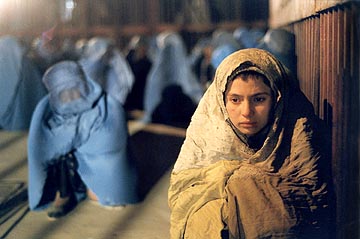Osama


The first time that most people heard of the Taliban was in the wake of 9/11. They had been active well before that, coming to power in the mid 90s during the Afghanistan Civil War. Their name surfaced briefly in the news in the summer of 2000 when they decided to destroy some 2,000 year old Buddhist statues in Bamian, some of the oldest free-standing Buddhist statues in the world, despite worldwide pleas to the contrary (including some from their few allies). Yet even before this, human rights groups decried their strict interpretation of Islamic law, or Sharia, especially the effect that it had upon women. The Taliban forced women to wear burkas, which covered their entire bodies. They did not allow them to receive an education. Any women caught outside without a male relative would be beaten. And women could not hold jobs. It is this treatment of women that inspired Siddiq Barmak to write and direct Osama, the first movie made in post-Taliban Afghanistan.
Osama is also an important picture historically. It's the first time that somebody like Barmak could make a picture like this, and it gives a glimpse into the lives of women under the oppressive Taliban regime. Yes, Barmak is biased against the Taliban, but with their draconian ways of punishing women, it is hard not to be. Filmwise, it is similar to many of the films coming out of neighboring Iran. Thematically, many of these films look at the plight of women. Barmak uses a cast of non-actors, here to surprising effect. And, Osama is sparsely told in a way that some may find boring. Here, none of the characters have names. "Osama" is the name given to the main character (Marina Golbahari) by a boy that knows who she really is.
This girl's mother (Zubaida Sahar) is a doctor, but must work clandestinely else face the wrath of the Taliban. However, it is getting too dangerous for her, especially since she has to travel. Moreover, there are no surviving male members of their family. The only solution they see is to cut her daughter's hair and dress her as a boy. This way, she can get a job and walk around without fear of getting beat. As a boy, the little girl is able to get a job with the help of a family friend, but despite this she is still extremely paranoid, and with good reason. A mullah notices her and corrals her, along with all the other boys to religious school. It seems that everything that happens to her just makes her life more dangerous. At school, the other kids taunt her because "he" looks like a girl.
Osama is able to be so moving because of an impending sense of dread. One gets the feeling that this girl is doomed no matter what she does, just because of her gender. Barmak claims that "her story is true" in most of the press materials, but this is not in the literal sense. There wasn't necessarily a girl who masqueraded as a boy in the Taliban regime. What he means is that every day, women in Afghanistan faced horrendous inequalities that deprived them of such basic rights as having a job. The reason that the girl has no name is that she can represent all the girls in Afghanistan. At the beginning of the film, he shows a group of women marching, demanding work. As soon as the Taliban arrives, it devolves into chaos, as they hose down anybody in their way. It's a bleak reminder of how bad things were, and hopefully a warning to never have things like this again in the future.